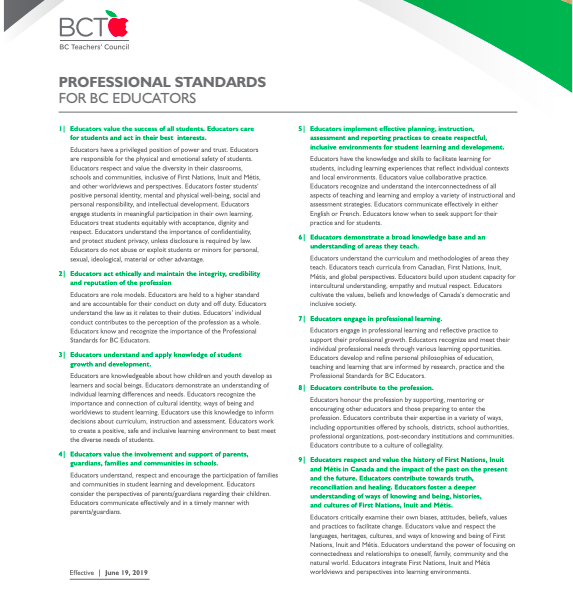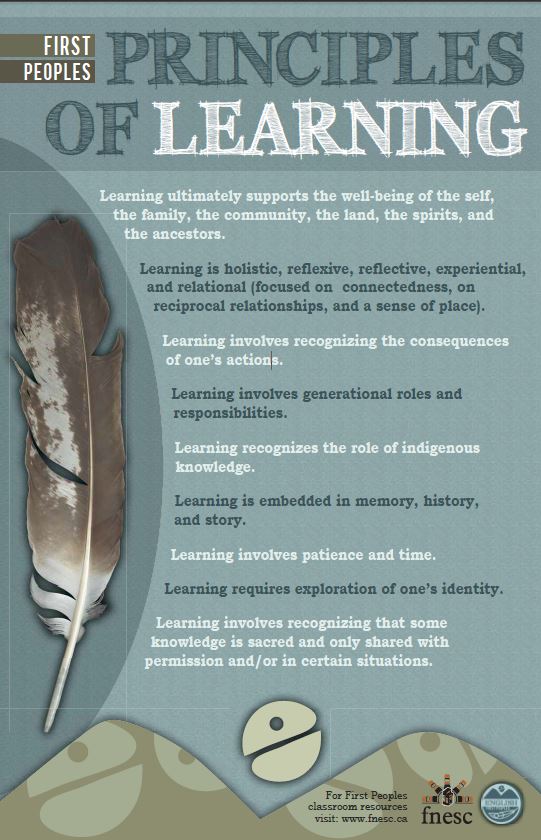
The Professional Standards for BC Teachers consists of nine standards that apply to all teachers in BC. The standards help to ensure that teachers create safe and inclusive spaces for all students. They also foster working towards reconciliation and acknowledging the history and contributions of Indigenous people. The standards are not just for teachers to uphold and ethically adhere to, but for parents and the community to understand the role of educators in the school. By following the standards, we are ensuring the success of all students, providing inclusive, culturally sensitive, and safe spaces to help our students learn.
curriculum_brochureTeachers in BC are mandated to teach the BC Curriculum. However, within that framework, teachers have autonomy to create learning that is flexible, relevant, and engaging. Flexibility allows teachers to draw on local contexts and community connections, as well as engage students in land-based learning. The curriculum was re-designed to include Aboriginal culture and perspectives weaved into each subject area. The curriculum is designed so that it encompasses the subjects students learn such as math and science, as well as what students need to know and be able to do. Each subject has core competencies which are sets of intellectual, personal, and social and emotional proficiencies that all students need to develop in order to engage in deeper learning. Content is what students need to know, curricular competencies are what students are expected to be able to do, and big ideas are what students are expected to understand.

The First Peoples Principles of Learning (FPPL) is a set of learning principles specific to First Peoples. These were articulated by Indigenous Elders, scholars and knowledge keepers to guide the development of the curriculum and teaching of the the English First Peoples course created by the BC Ministry of Education and First Nations Education Steering Committee in 2006/2007. The principles are meant to identify common elements in the varied teaching and learning approaches that Indigenous ways within the First Nations societies. Part of indigenizing our practice is to connect our lessons to the FPPL in meaningful and culturally sensitive ways. The FPPLs are not meant to be just listed off in lesson plans as a way to check the box so to speak. They are meant to be reflected upon and genuinely connected to our teaching.
Examples:
Learning is holistic, reflexive, reflective, experiential, and relational (focused on connectedness, on reciprocalrelationships, and a sense of place). Students will take a holistic approach and view of the butterfly’s life from egg tobutterfly, learn to watch over (care for) the egg though its live cycle stages and then release the butterflies back into nature. They will be able to reflect on the biology for a butterfly. There are many hands-on activities that will provide students opportunities to see how butterflies are part of the land and how they give back. (The last lesson they will hear facts about butterflies from National Geographic Kids book.)
Learning involves patience and time. Students will connect with being patient as the butterfly life cycle is observedthrough the classroom Butterfly station which will be a visual learning experience as they watch an egg become acaterpillar, then form a chrysalis and emerge as a beautiful butterfly.

The Truth and Reconciliation Commission (TRC) 94 Calls to Action is the result of the work done around the Residential Schools and its impact. The TRC provided a report that included the 94 Calls to Action which covers a wide range of areas including child welfare, education, health, justice, language, and culture. In our efforts towards reconciliation, its crucial to recognize the historical and ongoing wrongs carried out against Indigenous Peoples and the legacy of colonialism still in place today, which has resulted in negative impacts for generations on families, culture, and communities. The Call to Action is a framework to help Indigenous and Non-Indigenous to join together towards reconciliation. There are steps in place for teachers and schools to help with the reconciliation journey.
nicole-trudell-resume